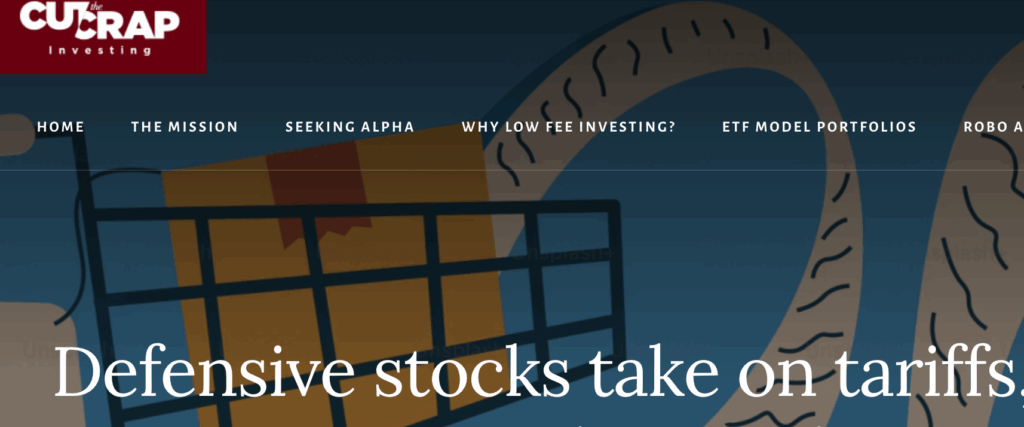By Dale Roberts, cutthecrapinvesting
Special to Financial Independence Hub
The year 2025 offered the third bear market for U.S. stocks in the last 6 years. That is surprising in itself. Canadian stocks didn’t go into a bear market but they did fall by near 13%. The good news for readers of this blog is that Canadian defensive stocks rose to the occasion. South of the border defensive sector equities were even more robust. Defensive stocks take on tariffs, on the Sunday Reads.

There’s more than one way to manage risk. Within a balanced portfolio the most common strategy is to use bonds to manage stock market risk and volatilty. We might then turn to gold that makes the balanced portfolio better. I also like using defensive equities, working in concert with bonds, cash and gold.
2025 Total Returns (through May):
Gold $GLD: +25% Developed International $VEA: +17% Canadian $XIC :+7.1% Silver $SLV: +14% Bitcoin $IBIT: +12% EM $IEMG: +9% US Bonds $AGG: +3% Cash $BIL: +2% Nasdaq 100 $QQQ: +2% REITs $VNQ: +1% S&P $SPY: +1% US Dollar $UUP: -7% Small Caps $IWM: -7% Oil $USO: -11%
Defensive sectors for retirement.
That’s a common theme or discussion in our Retirement Club for Canadians.

Let’s take a look at Canadian defensive stocks during the tariff-inspired bear market. The worst decline in 2025 for Canadian equities was January 30th to April 8th. The TSX Composite fell 12.9%.
From the beginning of the tariff tantrum to end of April …


Stock market down, defensives up – nice! 🙂
- Consumer staples (XST-T) up 12.1%
- Utilities (ZUT-T) up 11.1%
And be sure to check out this post – investing in Canadian utility stocks and ETFs.
Defensive sectors in the U.S.
If we look to U.S. stocks for the first quarter …

The U.S. defensive sectors all rose to the occasion. IVV = S&P 500.
Consumer staples (XLP), Utilities (XLU), Healthcare (XLV). Keep in mind, these are U.S. Dollar ETFs for U.S. dollar accounts. The most favourable tax treatment will be offered in your RRSP and Taxable accounts.
The defensive equities strategy has worked out wonderfully on both sides of the border.
Here’s the models in a retirement funding scenario from February through to the end of April. We start with $1,000,000 and spend at 4.8% of the portfolio value = $4,000 per month.

Of course, stocks have started to recover as Trump backs away (at times) from his tariff threats.

Canadian stocks move to all-time highs.
That said, the short test of the stock markets nerves and patience is relevant IMHO. Defensives reacted to risk. And they are likely to do so again. I’ve tested defensives through every correction from the dot com crash. We also know how types of stocks work in various market conditions, over the last 100 years.
Keep in mind past performance does not guarantee future returns. And when putting together the portfolio it’s important to keep some growth or equity market ETFs. If we overload on defensives, there’s the chance we underperform. Or in retirement we don’t experience the growth that we need.
But for Canadian equities, I’d have no problem holding ZLB-T.
U.S. defensives through the financial crisis
The recent performance of U.S. defensives was even better than the performance of the defensive sectors through the financial crisis, that left retirees with a portfolio almost twice as ‘big.’ In that post for Seeking Alpha I presented this chart …

Canadian Low Volatility
But even better than the defensive stocks was Canadian Low Volatility equities. You can look to BMO’s Low Volatility ETF – ZLB-T. I’ve put that ETF and index on the table for readers for quite some time. It’s nice to see that ETF ‘do its thing.
As Norm Rothery points out, low volatility is the top performing style in Canada.

More Sunday Reads
Dividend Hawk’s weekly review of portfolio assets offered summaries of a few Canadian bank stocks.
The Bank of Nova Scotia (BNS) Reports Second Quarter Results; BNS reported second-quarter non-GAAP EPS of C$1.52, a 3.8% decline year-over-year and C$0.03 below analyst expectations. Revenue rose 8.7% to C$9.08 billion, slightly missing estimates by C$10 million. The Common Equity Tier 1 (CET1) capital ratio improved to 13.2%, up approximately 30 basis points from the prior quarter. Provision for credit losses (PCL) came in at C$1.398 billion, significantly higher than C$1.007 billion in the same quarter last year and above the C$1.22 billion projected by analysts.
Royal Bank of Canada (RY) Reports Second Quarter 2025 Results; RY reported quarterly adjusted earnings per share (EPS) of C$3.12, up from C$2.92 in the same period last year but below analyst expectations of C$3.17. Revenue rose 10.7% year-over-year to C$15.67 billion, though it fell short of analyst estimates by C$70 million. The bank’s Common Equity Tier 1 (CET1) ratio remained steady at 13.2% compared to the previous quarter, marking a 40 basis point increase year-over-year. Provisions for credit losses totaled C$1.42 billion, an increase of C$504 million (55%) from a year ago and C$374 million (36%) from the previous quarter.
Canadian Imperial Bank of Commerce (CM) Announces Second Quarter 2025 Results; CM reported fiscal Q2 Non-GAAP EPS of C$2.05, a 14.5% increase from C$1.79 a year earlier and C$0.15 above analyst expectations of C$1.90. Revenue rose 14% year-over-year to C$7.02 billion, beating consensus estimates by C$120 million. The Common Equity Tier 1 (CET1) ratio was 13.4% as of April 30, 2025, slightly down from 13.5% in the previous quarter. Provision for credit losses increased to C$605 million, up C$91 million year-over-year.
A solid quarter for banks
It was a very solid reporting season for Canadian banks, though they have all set aside increasing provisions for credit losses. They are well fortified but those provisions certainly reduce profits reported.
At Findependence Hub more on how BMO’s ZLB-T is constructed.
At Banker on Wheels weekly review you’ll find a post from Morningstar on what they’ve learned from 150 years of stock market crashes.
Banker also points to a podcast that suggests owning a home is not a good way to build wealth. As Toronto homeowners, me and the Mrs. would beg to differ. Our home is a wonderful home first, but it certainly also turned out to be an accidental investment.
This Boomer agrees as well …
Sell in May? No way
Perhaps we don’t count out U.S. exceptionalism, just yet …
And May was stellar.
And after a strong May? …

At stocktrades.ca Dan offers his take on the best Canadian telco for the long haul.
Bob at Tawcan offers his monthly portfolio dividend report.
I will kindly suggest that Bob check out last week’s Sunday Reads – Dividends feel good, but they don’t create wealth.
Remember, dividends are of no special use in retirement as well – they don’t reduce sequence risk. There’s no difference between a share sale and a dividend, tax treatment excepted.
The superior portfolio wins. It comes down to total return and risk level. That’s it!
Join Cut The Crap Investing
You can follow this blog, it’s free. Newsletters, plus other free content and ‘ideas’ will be delivered to your email inbox. Enter your email in the subscribe area, or ‘join us today’ on the home page.
ETFs / Stock Portfolios / Retirement Strategies / Wealth Creation/ Retirement Club

 Dale Roberts is a former advertising writer and creative director and long time index investor. In 2013, he followed his passion to become an investment advisor, and then trainer at Tangerine Investments. He won Advisor of the Year in his first year. He left Tangerine in 2018 to start Cut The Crap Investing, where he helps investors learn how to use ETFs, simple stock portfolio models and Robo Advisors to full advantage in the accumulation stage, and especially in retirement. A ‘hyper-focuser’ Dale has spent thousands of hours studying retirement – from the financial planning aspects to the portfolio models that make it happen. Early in 2025 he co-founded Retirement Club for Canadians, described in this Findependence Hub blog. Keep in mind Dale is not a financial planner. Retirement Club provides ideas and learning for consideration. As we know, self-directed investors are responsible for their own investment decisions. This blog originally appeared on his site on June 1, 2025 and is republished with permission.
Dale Roberts is a former advertising writer and creative director and long time index investor. In 2013, he followed his passion to become an investment advisor, and then trainer at Tangerine Investments. He won Advisor of the Year in his first year. He left Tangerine in 2018 to start Cut The Crap Investing, where he helps investors learn how to use ETFs, simple stock portfolio models and Robo Advisors to full advantage in the accumulation stage, and especially in retirement. A ‘hyper-focuser’ Dale has spent thousands of hours studying retirement – from the financial planning aspects to the portfolio models that make it happen. Early in 2025 he co-founded Retirement Club for Canadians, described in this Findependence Hub blog. Keep in mind Dale is not a financial planner. Retirement Club provides ideas and learning for consideration. As we know, self-directed investors are responsible for their own investment decisions. This blog originally appeared on his site on June 1, 2025 and is republished with permission.


